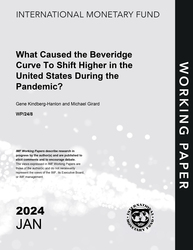
What Caused the Beveridge Curve to Shift Higher in the United States During the Pandemic?
What Caused the Beveridge Curve to Shift Higher in the United States During the Pandemic?
READ MORE...
Volume/Issue:
Volume 2024
Issue 008
Publication date: January 2024
ISBN: 9798400263415
$20.00
Add to Cart by clicking price of the language and format you'd like to purchase
Available Languages and Formats
| English |
Prices in red indicate formats that are not yet available but are forthcoming.
Topics covered in this book
This title contains information about the following subjects.
Click on a subject if you would like to see other titles with the same subjects.
Labor , Economics- Macroeconomics , Economics / General , Beveridge Curve , COVID , COVID pandemic , pandemic low , reallocation effect , worker admission , Labor force , COVID-19 , Labor shortages , Unemployment , Labor markets , Global
Summary
The Beveridge curve shifted substantially higher in the United States following the start of the COVID pandemic. In 2022, vacancies reached record highs across all sectors while unemployment fell to pre-pandemic lows. At the same time, the pandemic has resulted in severe labor shortages, and we estimate that the labor force was approximately 2 million below trend at the start of 2023. We exploit state-level data in the United States to find that lower immigration, higher excess mortality due to COVID, and falling older-worker labor force participation were associated with larger upward shifts in the Beveridge curve. We also find that states that had a larger employment concentration in contact-intensive sectors had larger upward shifts in their Beveridge curve. While the effect of sectoral reallocation and rehiring has been shown in theoretical models to lift the Beveridge curve, we show that worker shortages also result in an upward shift in the Beveridge curve if they increase the marginal product of labor. This result holds in a search and matching model with on-the-job search, but does not hold without on-the-job search.
Copyright © 2010 - 2025
Powered by:
AIDC



